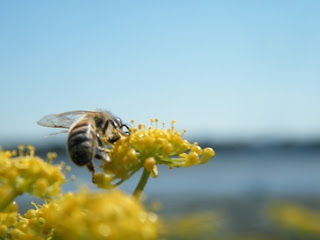If you lay in a forest full of bluebells and looked upwards, this is what you would see. Violet bliss.
Feral Bee
Saturday, May 30, 2015
Wednesday, September 12, 2012
Theory of bee relativity
 |
| (Photo: Sarah Phelan) |
I found one tonight at sunset, sheltering at the center of a yellow-petaled gum flower. As you can see from this photo, the little fella fits in just perfectly. Now I just need to get my hands on a macro lens and I'll really be able to show you what I mean
Tuesday, August 14, 2012
Wing surfing
Monday, August 13, 2012
Counting bees
 |
| Photos and text by Sarah Phelan Saturday was an adventure in bee counting for folks in the Bay Area,. Personally, I counted lots of honey bees in my back yard, all drawn there by my licorice-scented Agastache "Blue Fortune" or hyssop, as it's also known. Out along the Alameda shoreline, I saw metallic green sweat bees and longhorn bees in profusion on the gum plants. and anoccasional bumble bee bizzed-whizzed past us as we wandered past huge stands of wild fennel. Happy bee count! |
 |
| This is what Agastache "Blue Fortune" looks like, in case you are wondering. |
Sunday, August 5, 2012
The bumble bee nest in my mother's garden
Thursday, July 19, 2012
Teddy bear bees really do exist
 |
| Add caption |
Wednesday, June 20, 2012
Solstice cats and bees
 |
| The only creatures already stirring in my yard at sunrise on the summer solstice were bees. |
 |
| Oh yes, and the cat, who was, of course, pretending not to be watching the bees. |
 |
| Hell, he even averted his gaze when I tried to get a better shot. |
 |
| But the bees were oblivious and had already collected great gobs of pollen, despite the early hour. Happy solstice! Try to enjoy all fourteen hours and forty-seven minutes of daylight today. |
Subscribe to:
Comments (Atom)






